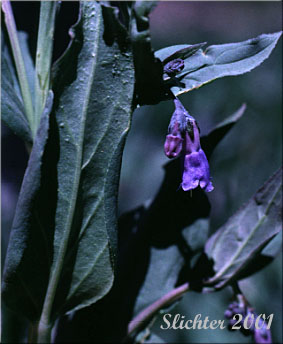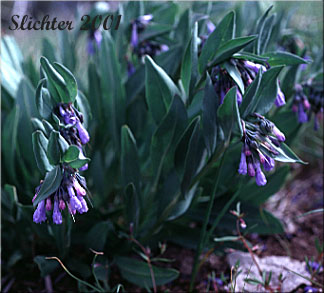 The
photo at right represents Mertensia oblongifolia from Jackman Park C.G.,
Steens Mt.....June 24, 2000.
The
photo at right represents Mertensia oblongifolia from Jackman Park C.G.,
Steens Mt.....June 24, 2000.
Leafy bluebells is an attractive wildflower with several to many erect stems from 10-40 cm high. The basal leaves are elliptic, oblanceolate, or lance-ovate in shape with blades 2-15 cm long and 0.7-6 cm wide on a well-developed petiole. The numerous stem leaves are well developed and longer than the internodes (space between leaves), ranging from 2.5-7 times as long as wide. They are acute to obtuse at the tip and only the lower leaves are petiolate.
The inflorescence consists of several clusters of drooping flowers at the ends of the stems. The tubular corolla is 1-2 cm in length with the tube 1.3-2 times longer than the slightly expanded limb (distal portion of the corolla). The calyx is 2.5-6 mm long and cleft to near the base.
Leafy bluebells may be found on open slopes, in dry meadows, and often among sagebrush from the plains and foothills to moderate elevations in the mountains.
Leafy bluebells may be found entirely east of the Cascades south to central Nevada and northern Utah (Wasatch and Bear River ranges), and east to the edge of the Great Plains (eastern edge of the Rocky Mts.) in northern Wyoming.
In the Columbia River Gorge it is only found at an elevation of 2800' at the crest of the Columbia Hills north and east of the Dalles, OR.
